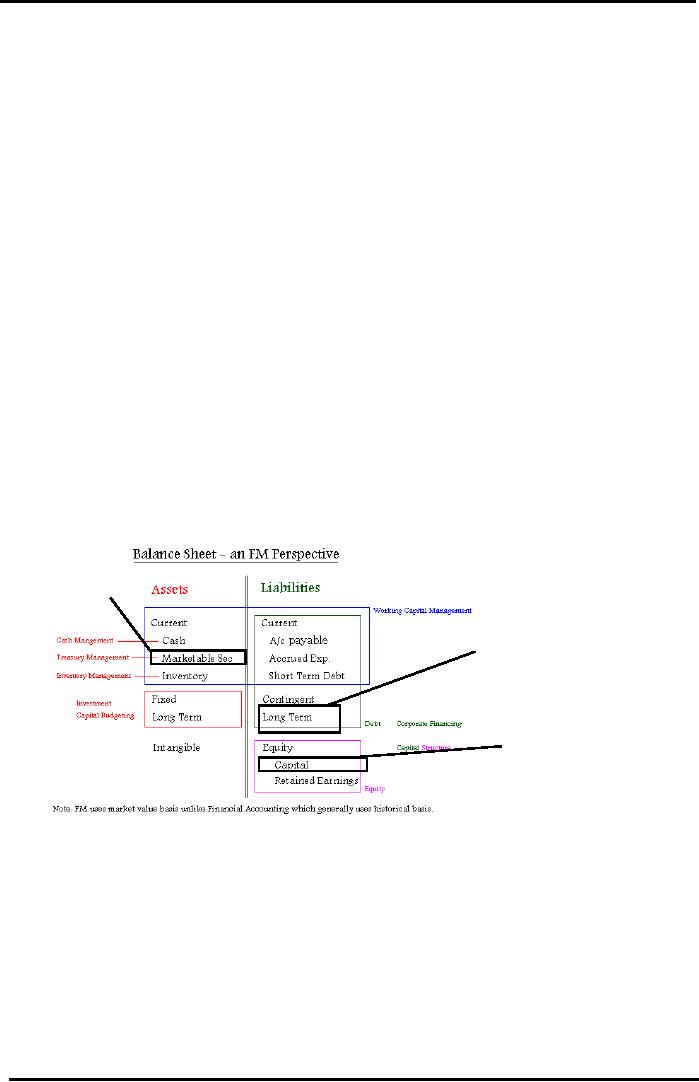 |

Financial
Management MGT201
VU
Lesson
28
INTRODUCTION
TO DEBT, EFFICIENT MARKETS AND
COST OF CAPITAL
Learning
Objectives:
After
going through this lecture,
you would be able to have an
understanding of the following
topics
·
Intro
to Debt, Efficient Markets & Cost of
Capital
In
today's lecture, we will
start our discussion on
capital structure and corporate financing.
The first
thing
which we study about the
capital structure is the over view of the
financial markets. We have
mentioned
that there are two main
sources of capital raising
i.e. debt and equity.
There are various
financial
markets where the money is
available.
Capital
Markets:
Stock
Exchange (listed shares, unit
trusts, TFC):
In
the case of capital market we have
study the stock exchange where the common or
preferred
stocks
of companies are traded. In these we have
the supply or availability of the equity
capital.
Money
Markets (Short-term liquid
debt market):
It
is the market for short term debt. and it
includes the debt instruments like
term finance
certificates
and bonds etc. bank loans
,leases from leasing company , mortgage
agreements from house
building
finance corporation insurance policy ,
credit cards and various
other things .it also
includes
bank
deposits certificates and inter
bank short term and over night
borrowing and lending Bonds
Real
Assets Markets:
The
real asset market where the
real or tangible asset or
physical asset change hand
.for
example,
you have cotton exchange where
raw bales of cotton change
hands .computer hardware and
many
other examples are
available. For example,
Cotton Exchange, Gold Market,
Kapra
Market
Property
(land, house, apartment, warehouse)
,Computer hardware, Used Cars, Wheat,
Sugar,
Vegetables,
etc.
Debt
and Equity
Markets:
Equity
Markets and
Institutions
Stock
Exchanges
Private
Placements
Private
Equity Investments
Venture
Capital
Islamic
Finance
Debt
Markets and
Institutions
Bond
Markets
Money
Markets & Call
Markets
Bank
Loans & Certificate of Deposits
(CD's)
Project
Financing
Running
Finance or Working Capital Finance
Hypothecation
and Pledge Financing for Inventory
Purchase
Bridge
Financing
Mortgage
Financing
Lease
Financing
Insurance
and Credit Card
In
previous lectures we have studied
about the efficient markets.
Efficient
Markets" Assumption:
We
assume that Financial
Markets are quick and Prices
are Right. There are
Lots of Rational
Investors
in every Financial Market.
They are all well-informed
and act quickly on information
related
to
the companies' operations, finances, risk and
return. So Prices of Securities (like
Stocks and Bonds)
adjust
(equilibrate) quickly to new
information. Pricing by the Market is
Efficient and Accurate.
Observed
Market Price is accurate reflection of
Fair Price (or Theoretical Price
based on Investors'
NPV
calculations).
All
Stocks have Optimal Risk-Return
Combinations, i.e. All Stocks
lie right ON the SML
Line!
Securities:
These
are pieces of legal
contractual paper that
represent claim against
assets
Direct
Claim Securities:
120

Financial
Management MGT201
VU
Stocks:
it is
equity paper representing ownership,
shareholding. Appears on Liabilities
side of
Balance
Sheet
Bonds:
it is
debt paper representing loan or
borrowing.
When
you are issuing Bonds (i.e.
borrowing money) then the
Value of Bonds
appears
under Liabilities side (as
Long Term Debt) of Balance
Sheet.
If
you are Investing (or
buying) Bonds of other
companies then their
Value
appears
under Assets side (as
Marketable Securities) of Balance
Sheet.
Value
of Direct Claim Security is
directly tied to the value of the
underlying Real Asset.
Why
Take Debt?
If
you do NOT have enough money to
meet your own or your
family's personal living
expenses,
then
you approach a friend or a Bank
for a Personal Loan.
If
you can NOT find
friends, family, or investors who
want to invest Equity into
your business
venture,
then you approach an Individual
Lender or Bank or Leasing
Company for a Business Loan.
In
an
Emergency or Crisis, the quickest way to
get money is generally to take a
Loan at a high interest rate.
Countries
that are short of money do
this too.
Debt
vs. Equity:
If
the Company raises money
using Debt or Bonds, then it
will have to pay a fixed amount
of
interest
(or mark-up) regularly for a
limited amount of time. Of course,
failure to pay interest
can
force
company to close down.
If
the Company raises money
using Equity, then it is
forced to bring in new
shareholders who are
Owners
& can interfere in the management and
will get a share of the net profits
(or dividends) for
as
long as the company is in
operation
Where
Do Bonds & Stocks Appear on
the
Balance
Sheet?
Stocks
&
Bonds
Purchased
as
Investment
Own
Bonds
Issued
by
Company
to Raise Cash
Own
Stock
Issued
by
Company
to Raise Cash
Capital
Structure:
Most
Firms keep a Mix of Both Debt and
Equity Capital. In other words
most Firms raise
money
from both Stockholders (and Shareholders)
and Bondholders (and
Banks).
The
Mixture or Proportion of Debt
Capital and Equity Capital
are known as the Capital
Structure.
This
Financial Policy Decision is
taken by the CEO, CFO, and Board of
Directors
Capital
Structure can Change With
Time depending on Firm's
Financing needs and strategy.
Some
Projects
like Power Plants and Cement
are so Capital Intensive and
large that initially the
sponsors need
Debt
Capital When a Running
Business reaches maturity,
some owners prefer to fix the Ratio of
Debt to
Equity
at 20/80 and only for
Running Finance. Some Muslim
Businessmen use 100% Equity
Capital
only
(No Debt).
121

Financial
Management MGT201
VU
Cost
of Capital: Firms
try to attract Debt and
Equity Investors to invest
their Capital (or money).
Firms
claim
that they are SAFE
and PROFITABLE investments. Therefore,
Firms try to Get
Investment
Capital
(or money) at the LOWEST possible
Cost of Capital.
Remember
that whenever you Borrow or
Rent or Buy anything (cycle,
house, money), it
Costs
You
Money in the form of a Rental,
Interest or Mark-up, Installment,
etc.
Stockholders
(Equity owners) expect to receive
Dividends
Bondholders
(Debt Holders and Banks) expect to
receive Interest
Cost
of Capital & Required ROR:
Required
ROR (or Opportunity Cost)
%:
CAPM
Theory (SML for Efficient
Markets) & NPV
Minimum
ROR required attracting investor
into buying a Security (i.e.
Stock or Bond ...)
Opportunity
Cost: Investor Sacrifices the ROR available
from the 2nd best
investment.
Cost
of Capital %:
Weighted
Average Cost of Capital
(WACC)
Combined
costs of all sources of
financing used by Firm (i.e.
Debt and Equity)
WACC
is Similar to Required ROR BUT
Takes into account some
Practical Factors:
Taxes:
Interest
Payments are P/L Expenses
and NOT Taxed.
Transaction
costs: Brokerage,
Underwriting, Legal, and
Flotation Costs
incurred
when
a Firm issues Stocks or Bond
Securities
WACC
%Weighted
Average Cost of
Capital
Assume
that Firm markets 3 Types of
Financial Products (or Securities or
Instruments) to attract
Investors'
Capital.
Bonds
(Debt):
Cost
= Coupon Interest
Common
Shares (Equity): Cost =
Variable Dividend
Preferred
Shares (Hybrid Equity): Cost
= Fixed Dividend
The
Firm Issues a Security or
Financial Instrument to the Investor and
Receives Capital (or
Money)
in
exchange. The Firm has to
pay a "Rental
Cost" for
using the Investors'
Capital.
WACC
% = Weighted % Cost of Debt +
Weighted
% Cost of Common Equity
+
Weighted
% Cost of Preferred Equity =
rDxD +
rExE +
rPxP
WACC
must take Taxes & Transaction
Costs into
account
Security
Market Line (SML)
For
Market of Efficient
Stocks
Stock
A lies
rA =
rRF +
(rM -
rRF )
.
Required
A
ON
the
SML
Line.
Efficient
Return
(r*)
Risk-Return
rA= 30%
Combination
Security
Market Line
rM=
20%
Risky
Stock A's
rRF= 10%
Risk
Premium
=
30-10 = 20%
A
=+ 2.0
M
=+ 1.0
Beta
Risk (
)
122

Financial
Management MGT201
VU
Summary
of Formulas:
Total
risk=
market risk + company specific
risk
σ
2
+
β 2σ
2
+
σ 2
NPV
Bond Pricing
Equation:
Bond
Price = PV = C1/ (1+rD) + C2 (1+rD)
2 +
C3 / (1+rD)3
+
.....
+ PAR / (1+rD)3
Gordon's
Formula for Share
Pricing:
rCE = (DIV 1 /
Po) + g = Dividend Yield + Capital
Gains Yield
SML
Equation (CAPM
Theory)
r
= rRF + Beta (rM
- rRF)
123
Table of Contents:
- INTRODUCTION TO FINANCIAL MANAGEMENT:Corporate Financing & Capital Structure,
- OBJECTIVES OF FINANCIAL MANAGEMENT, FINANCIAL ASSETS AND FINANCIAL MARKETS:Real Assets, Bond
- ANALYSIS OF FINANCIAL STATEMENTS:Basic Financial Statements, Profit & Loss account or Income Statement
- TIME VALUE OF MONEY:Discounting & Net Present Value (NPV), Interest Theory
- FINANCIAL FORECASTING AND FINANCIAL PLANNING:Planning Documents, Drawback of Percent of Sales Method
- PRESENT VALUE AND DISCOUNTING:Interest Rates for Discounting Calculations
- DISCOUNTING CASH FLOW ANALYSIS, ANNUITIES AND PERPETUITIES:Multiple Compounding
- CAPITAL BUDGETING AND CAPITAL BUDGETING TECHNIQUES:Techniques of capital budgeting, Pay back period
- NET PRESENT VALUE (NPV) AND INTERNAL RATE OF RETURN (IRR):RANKING TWO DIFFERENT INVESTMENTS
- PROJECT CASH FLOWS, PROJECT TIMING, COMPARING PROJECTS, AND MODIFIED INTERNAL RATE OF RETURN (MIRR)
- SOME SPECIAL AREAS OF CAPITAL BUDGETING:SOME SPECIAL AREAS OF CAPITAL BUDGETING, SOME SPECIAL AREAS OF CAPITAL BUDGETING
- CAPITAL RATIONING AND INTERPRETATION OF IRR AND NPV WITH LIMITED CAPITAL.:Types of Problems in Capital Rationing
- BONDS AND CLASSIFICATION OF BONDS:Textile Weaving Factory Case Study, Characteristics of bonds, Convertible Bonds
- BONDS’ VALUATION:Long Bond - Risk Theory, Bond Portfolio Theory, Interest Rate Tradeoff
- BONDS VALUATION AND YIELD ON BONDS:Present Value formula for the bond
- INTRODUCTION TO STOCKS AND STOCK VALUATION:Share Concept, Finite Investment
- COMMON STOCK PRICING AND DIVIDEND GROWTH MODELS:Preferred Stock, Perpetual Investment
- COMMON STOCKS – RATE OF RETURN AND EPS PRICING MODEL:Earnings per Share (EPS) Pricing Model
- INTRODUCTION TO RISK, RISK AND RETURN FOR A SINGLE STOCK INVESTMENT:Diversifiable Risk, Diversification
- RISK FOR A SINGLE STOCK INVESTMENT, PROBABILITY GRAPHS AND COEFFICIENT OF VARIATION
- 2- STOCK PORTFOLIO THEORY, RISK AND EXPECTED RETURN:Diversification, Definition of Terms
- PORTFOLIO RISK ANALYSIS AND EFFICIENT PORTFOLIO MAPS
- EFFICIENT PORTFOLIOS, MARKET RISK AND CAPITAL MARKET LINE (CML):Market Risk & Portfolio Theory
- STOCK BETA, PORTFOLIO BETA AND INTRODUCTION TO SECURITY MARKET LINE:MARKET, Calculating Portfolio Beta
- STOCK BETAS &RISK, SML& RETURN AND STOCK PRICES IN EFFICIENT MARKS:Interpretation of Result
- SML GRAPH AND CAPITAL ASSET PRICING MODEL:NPV Calculations & Capital Budgeting
- RISK AND PORTFOLIO THEORY, CAPM, CRITICISM OF CAPM AND APPLICATION OF RISK THEORY:Think Out of the Box
- INTRODUCTION TO DEBT, EFFICIENT MARKETS AND COST OF CAPITAL:Real Assets Markets, Debt vs. Equity
- WEIGHTED AVERAGE COST OF CAPITAL (WACC):Summary of Formulas
- BUSINESS RISK FACED BY FIRM, OPERATING LEVERAGE, BREAK EVEN POINT& RETURN ON EQUITY
- OPERATING LEVERAGE, FINANCIAL LEVERAGE, ROE, BREAK EVEN POINT AND BUSINESS RISK
- FINANCIAL LEVERAGE AND CAPITAL STRUCTURE:Capital Structure Theory
- MODIFICATIONS IN MILLAR MODIGLIANI CAPITAL STRUCTURE THEORY:Modified MM - With Bankruptcy Cost
- APPLICATION OF MILLER MODIGLIANI AND OTHER CAPITAL STRUCTURE THEORIES:Problem of the theory
- NET INCOME AND TAX SHIELD APPROACHES TO WACC:Traditionalists -Real Markets Example
- MANAGEMENT OF CAPITAL STRUCTURE:Practical Capital Structure Management
- DIVIDEND PAYOUT:Other Factors Affecting Dividend Policy, Residual Dividend Model
- APPLICATION OF RESIDUAL DIVIDEND MODEL:Dividend Payout Procedure, Dividend Schemes for Optimizing Share Price
- WORKING CAPITAL MANAGEMENT:Impact of working capital on Firm Value, Monthly Cash Budget
- CASH MANAGEMENT AND WORKING CAPITAL FINANCING:Inventory Management, Accounts Receivables Management:
- SHORT TERM FINANCING, LONG TERM FINANCING AND LEASE FINANCING:
- LEASE FINANCING AND TYPES OF LEASE FINANCING:Sale & Lease-Back, Lease Analyses & Calculations
- MERGERS AND ACQUISITIONS:Leveraged Buy-Outs (LBO’s), Mergers - Good or Bad?
- INTERNATIONAL FINANCE (MULTINATIONAL FINANCE):Major Issues Faced by Multinationals
- FINAL REVIEW OF ENTIRE COURSE ON FINANCIAL MANAGEMENT:Financial Statements and Ratios